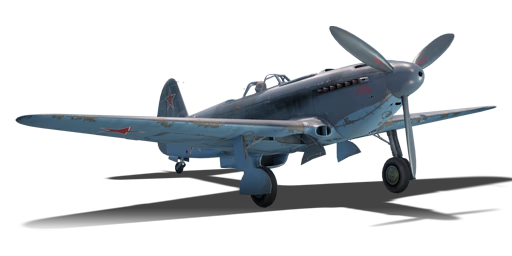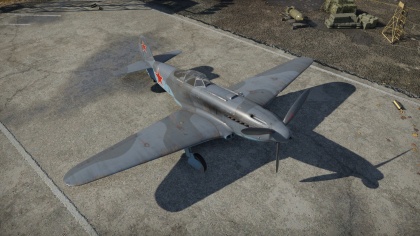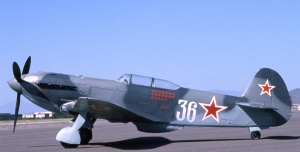Yak-9U
Contents
| This page is about the Russian fighter Yak-9U. For other versions, see Yak-9 (Family). |
Description
The Yak-9U is a rank Russian fighter
with a battle rating of (AB), (RB), and (SB). It was introduced in Update 1.37.
The Yak-9 was a Soviet single-engine fighter of the WWII era. It was the first combat aircraft designed by Alexander Yakovlev's construction bureau. The most mass-produced Soviet fighter of the war, it remained in production from October 1942 to December 1948, with a total of 16,769 built.
The Yak-9 was a further modification of the Yak-1 and Yak-7B. In its core design, it was a redesign of the Yak-7. With few external differences, Yak-9 was at the same time much more advanced internally. This is not unexpected, as almost two years of design and combat experience of the Yak series went into the Yak-9. Also, at the time aluminium was in much greater supply than it had been two years previously at the start of the war. Amongst other things, the use of metal allowed the plane's weight to be significantly reduced, meaning that more fuel could be stored and that the aircraft could be equipped with more powerful armament and more specialised equipment.
The Yak-9U is a redesign of the Yak-9. The Yak-9U entered into service in 1943, less than an year before the Yak-3 (even though the Yak-3 is before the Yak-9U in the Tech Tree) and has the same armament (2 x Berezin UB 12.7 mm with 170 rounds per gun and 1 x ShVAK cannon with 120 shells). The Yak-9U is faster and more resilient, but also heavier.
The Yak-9U is an up-engined Yak-9 equipped with the M-107A engine. It sports competitive speed, far above average turning and roll abilities, good acceleration, a high dive limit (by USSR standards), and keeps nice and crisp controls from speeds as low as 250 km/h to 750 km/h. It is arguably the most underestimated vehicle rank-for-rank in the game and is often skipped by players who view it as just another Yak-9.
Unlike previous Yak-9s equipped with the VK-105PF engine, the Yak-9U gets a significant upgrade in the form of its M-107A engine (which also happens to be the engine utilized by the premium Yak-3 (VK-107) and the later Yak-9P/UT). As such, the Yak-9U is one of the fastest planes at sea level at 4.3 and retains excellent performance up to ~6 km where it can effectively engage higher-speed American and faster climbing German planes. This, combined with the excellent handling and turn-fighting qualities allow the Yak-9U to effectively dictate any engagement- a pilot can turn-fight Bf 109s and P-47s with ease while having the capability to outrun slower yet more manoeuvrable vehicles such as the Spitfire.
At sea level, the Yak-9U can catch most, if not all, planes at 4.3 BR, including the P-47 and P-51D. Beware, however, as the Yak airframe isn't particularly durable in a dive and will rip at speeds above 750 kph IAS. Thankfully, forcing an opponent down low effectively seals their fate as you and your team perform optimally at low altitude.
General info
Flight performance
| Characteristics | Max Speed (km/h at 5,000 m) |
Max altitude (metres) |
Turn time (seconds) |
Rate of climb (metres/second) |
Take-off run (metres) | |||
|---|---|---|---|---|---|---|---|---|
| AB | RB | AB | RB | AB | RB | |||
| Stock | 652 | 634 | 20.1 | 20.7 | 14.9 | 14.9 | 380 | |
| Upgraded | 699 | 677 | 18.6 | 19.1 | 22.9 | 18.8 | ||
Details
| Features | |||||
|---|---|---|---|---|---|
| Combat flaps | Take-off flaps | Landing flaps | Air brakes | Arrestor gear | |
| X | X | ✓ | X | X | |
| Limits | ||||
|---|---|---|---|---|
| Wing-break speed (km/h) |
Gear limit (km/h) |
Combat flaps (km/h) |
Max Static G | |
| + | - | |||
| 410 | ~11 | ~8 | ||
| Optimal velocities | |||
|---|---|---|---|
| Ailerons (km/h) |
Rudder (km/h) |
Elevators (km/h) |
Radiator (km/h) |
| < 400 | < 420 | < 490 | > 450 |
| Compressor (RB/SB) | ||
|---|---|---|
| Setting 1 | ||
| Optimal altitude | 100% Engine power | WEP Engine power |
| 1,890 m | 1,650 hp | 1,749 hp |
| Setting 2 | ||
| Optimal altitude | 100% Engine power | WEP Engine power |
| 4,500 m | 1,500 hp | 1,590 hp |
Survivability and armour
- 64 mm Bulletproof glass in cockpit front and rear.
- 8 mm Steel plate behind the pilot.
Armaments
Offensive armament
The Yak-9U is armed with:
- 1 x 20 mm ShVAK cannon, nose-mounted (120 rpg)
- 2 x 12.7 mm Berezin UB machine guns, nose-mounted (170 rpg = 340 total)
Usage in battles
The Yak-9U offers incredible speed, climb and maneuverability with the same complementary firepower. The Yak-9U plays very well as Boom and Zoomer, it is important to make sure that you climb to around 4000-5000 meters (13123-16404 feet), most enemies will be around 2500 to 3800 meters (8202 to 12467 feet), with enemy bombers being around 3500 to 4000 meters (11482 to 13123 feet). Climbing to 5000 meters (16404 feet) will allow you to perform the boom and zoom maneuver perfectly, allowing you to keep your speed advantage in the climb back up to 5000 meters.
At the 3500 to 4000 meter (11482 to 13123 foot) height, you will encounter mostly enemy bombers to engage the bombers climb above them and aim for the wings. Using the 20 mm cannon to penetrate the fuel tanks which are placed in the wings, will cause them to lose fuel and if using a HE round, will create fires. An additional advantage, of using this attack approach could possibly cause critical damage to critical flight surfaces and structure i.e. wing spars, engines, and ailerons.
Another way to bring bombers down is if they lack belly gunners, fly under them then pull up firing a short bust into the front of the bomber, knocking the flight crew out. If going head on with a bomber, aim for the flight deck or one of the engines. Make sure to take evasive action to avoid the machine gun fire, fired from their frontal turrets.
Engaging fighters, it's important to keep an eye on your speed in the dive, since the YAK-3P offers excellent speed, when not fully upgraded it's easy to rip the wings off in the dive, it is also very easy to be distracted and just focus on the enemy plane. Instead, use the ruder in the descending the turn, this will help slow you down, while keeping your speed at a very high amount. To knock your target out in one blow, overshoot it then turn into it and descend with speed, as the enemy turns into your turn, point the nose down and fire a one to two second bust and pull up and climb back to the altitude and repeat, if it didn't explode.
The Yak-9U offers no bombs, rockets or any secondary payloads, it is an air supremacy fighter armed only with machine guns and cannons. They must be used to defend your ground forces or naval fleets from enemy bombers and fighter bombers. Stay high, use the boom and zoom tactics to your advantage - do not strafe tanks or ships, the 20 mm cannons only offer 120 rounds which will be needed in any air to air combat engagement.
Manual Engine Control
| MEC elements | ||||||
|---|---|---|---|---|---|---|
| Mixer | Pitch | Radiator | Supercharger | Turbocharger | ||
| Oil | Water | Type | ||||
| Controllable | Controllable Not auto controlled |
Controllable Not auto controlled |
Controllable Auto control available |
Separate | Controllable 2 gears |
Not controllable |
Modules
| Tier | Flight performance | Survivability | Weaponry | |
|---|---|---|---|---|
| I | Fuselage repair | Radiator | Offensive 12 mm | |
| II | Compressor | Airframe | New 12 mm MGs | |
| III | Wings repair | Engine | Offensive 20 mm | |
| IV | 100 octane fuel usage | Engine injection | Cover | New 20 mm cannons |
Pros and cons
Pros:
- MEC negates overheating, set radiator to 100%/75% at low/high altitudes respectively
- Excellent cockpit visibility
- Excellent handling and manoeuvrability at most speed bands
- Good rate of turn
- Good rate of climb
- Good diving speeds
- Performs identically to the Yak-9P and Yak-9UT while being at a lower BR
- Nose-mounted weaponry
Cons:
- Relatively low ammo count
- Overheating is a very real issue, do not abuse the throttle
History
Historical design and development
During December 1943, the creation of a new airframe (Yak-9U) allowed the installation of the M-107A engine, which was more powerful than the previous VK-105PF. The engine mount was brand new and included individual faired exhaust pipes, wings, and fuselage structure that was made of metal while the whole aircraft received a covering of Bakelite skin. The horizontal tail surfaces were slightly reduced in order to afford the aircraft improved pitch control. The oil cooler intake was re-positioned from beneath the nose to the port wing root as well as an enlarged radiator bath being moved further aft under the fuselage. A supercharger intake was centred on the top decking of the engine cowling. The rear antenna cable was moved inside a lengthened rear canopy which featured a more aerodynamically refined shape with a modified fuselage deck contour. The The typical armament of the Yak-9U was a 20mm (79 cal) ShVAK cannon with 120 rounds that was fired through the aircraft's hollow propeller shaft, and two 12.7mm (50 cal) Berezin UB machine guns with 340 rounds.
January to April 1944 marked the commencement of State trials and revealed that the Yak-9U had a superior top-speed compared to all fighters in service on the Eastern front at 6,000 m (19,685 ft). Unlike the I-185 the Yak-9U was a much simpler to fly and stable aircraft. Ultimately the M-107A engine inherited all the problems of the VK-105PF engine. The engine was prone to overheating, oil leaks, loss of engine pressure during climbs, spark plugs constantly burning out, and intense vibrations which would fatigue assembly bolts leading to a short engine life. These defects forced the first production batches starting during April 1944 to be powered by the reliable M-105 PF-3 engine. Further changes would include the fuel capacity of the Yak-9U being upgraded to 400L (106 US gal) and in order to re-balance the aircraft, the wings where moved 9.906 centimeters (3.9in) forward and the aircraft's VlSh-107LO propeller being replaced with the older VISH-105S. A total production of 1,134 aircraft where constructed by December 1944.
The model in-game does not sport the production batch's modifications as it is the prototype trial model.
In-game description
The Yak-9 was a Soviet single-engine fighter of the WWII era. It was the first combat aircraft designed by Alexander Yakovlev's construction bureau. The most mass-produced Soviet fighter of the war, it remained in production from October 1942 to December 1948, with a total of 16,769 built.
The Yak-9 was a further modification of the Yak-1 and Yak-7. In its core design, it was a redesign of the Yak-7. With few external differences, Yak-9 was at the same time much more advanced internally. This is not unexpected, as almost two years of design and combat experience of the Yak series went into the Yak-9. Also, at the time aluminium was in much greater supply than it had been two years previously at the start of the war. Amongst other things, the use of metal allowed the plane's weight to be significantly reduced, meaning that more fuel could be stored and that the aircraft could be equipped with more powerful armament and more specialized equipment.
Media
- Skins
- Videos
See also
Links to the articles on the War Thunder Wiki that you think will be useful for the reader, for example:
- reference to the series of the aircraft;
- links to approximate analogues of other nations and research trees.
External links
Paste links to sources and external resources, such as:
- topic on the official game forum;
- encyclopedia page on the aircraft;
- other literature.
| A.S. Yakovlev Design Bureau (Яковлев Опытное конструкторское бюро) | |
|---|---|
| Fighters | |
| Yak-1 | Yak-1 · Yak-1B |
| Yak-3 | Yak-3 · Eremin's Yak-3(e) · Yak-3 (VK-107) · Yak-3P · Yak-3T · Yak-3U |
| Yak-7 | Yak-7B |
| Yak-9 | Yak-9 · Yak-9B · Yak-9K · Golovachev's Yak-9M · Yak-9P · Yak-9T · Yak-9U · Yak-9UT |
| Twin-engine fighters | I-29 |
| Jet fighters | |
| Yak-15 | Yak-15P · Yak-15 |
| Yak-17 | Yak-17 |
| Yak-23 | Yak-23 |
| Yak-30 | Yak-30D |
| Yak-141 | Yak-141 |
| Strike aircraft | |
| Yak-2 | Yak-2 KABB |
| Yak-38 | Yak-38 · Yak-38M |
| Bombers | Yak-4 |
| Jet bombers | Yak-28B |
| Foreign use | ▄Yak-3 · Challe's ▄Yak-9T · ◔Yak-9P |
| Captured | ▀Yak-1B |
| USSR fighters | |
|---|---|
| I-15 | I-15 WR · I-15 M-22 · I-15 M-25 · I-15bis · Krasnolutsky's I-15bis |
| I-153 M-62 · Zhukovsky's I-153-M62 · I-153P | |
| I-16 | I-16 type 5 · I-16 type 10 · I-16 type 18 · I-16 type 24 · I-16 type 27 · I-16 type 28 · I-180S |
| I-29 | I-29 |
| I-185 | I-185 (M-71) · I-185 (M-82) |
| I-225 | I-225 |
| ITP | ITP (M-1) |
| MiG-3 | MiG-3-15 · MiG-3-15 (BK) · MiG-3-34 |
| LaGG | I-301 · LaGG-3-4 · LaGG-3-8 · LaGG-3-11 · LaGG-3-23 · LaGG-3-34 · LaGG-3-35 · LaGG-3-66 |
| La | La-5 · La-5F · La-5FN · La-7 · Dolgushin's La-7 · La-7B-20 · La-9 · La-11 |
| Yak-1/7 | Yak-1 · Yak-1B · Yak-7B |
| Yak-3 | Yak-3 · Eremin's Yak-3(e) · Yak-3P · Yak-3T · Yak-3U · Yak-3 (VK-107) |
| Yak-9 | Yak-9 · Yak-9B · Golovachev's Yak-9M · Yak-9T · Yak-9K · Yak-9U · Yak-9UT · Yak-9P |
| Other countries | ▂P-40E-1 · ▂P-47D-27 · ▂Hurricane Mk IIB · ▂Fw 190 D-9 · ▂Spitfire Mk IXc |
| P-39 | ▂P-39K-1 · ▂Pokryshkin's P-39N-0 · ▂P-39Q-15 |
| P-63 | ▂P-63A-5 · ▂P-63A-10 · ▂P-63C-5 |






